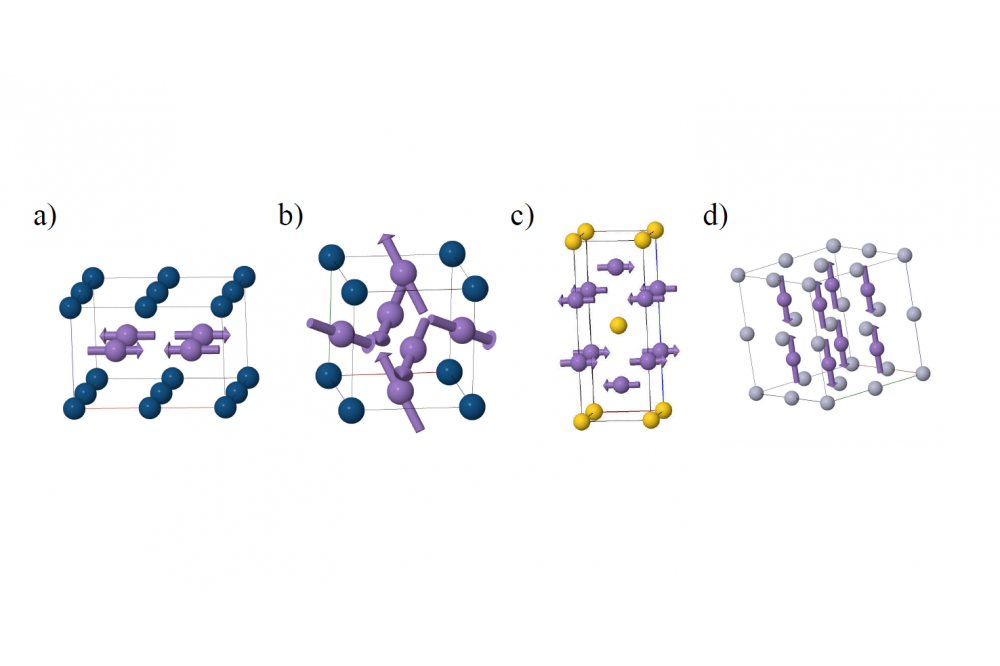High Throughput Optimization of Permanent Magnetic Materials
Einleitung
Magnetic materials are key components for energy harvesting and conversion, information technology and sensor applications. In this project we aim at the computational design of new magnetic materials with a focus on permanent magnets. Basic requirements for a good permanent magnet material are a large uniaxial magnetocrystalline anisotropy energy (MAE), a large saturation magnetization and a high Curie temperature. A reliable prediction of new functional magnetic materials requires a sufficient characterization of the thermodynamic stability (including competing phases) and characterization of the intrinsic magnetic properties, which is addressed within the present project using high-throughput density functional calculations.
Methoden
High-throughput density functional calculations are performed using an extended version of the high-throughput environment HTE [8, 9], which is a python based high-throughput environment for resource efficient and automated job submission and evaluation on High Performance Computers. Within this project, the HTE has been extended for the calculation of magnetic properties (including MAE, detection of magnetic ground states), automated detection of suitable positions for interstitial atoms and phase diagrams for high pressure synthesis. For structure optimizations and the calculation of formation energies we use the VASP code. All structures are optimized with a high cut-off energy and density of k-points. For the calculation of the MAE, which requires high accuracy, FPLO or WIEN2k are used with the optimized structure obtained from VASP.
Ergebnisse
Within this project, we have built up a database with the energetics of several ten thousands of structures focused on alloys with the magnetic 3d transition metals Fe, Co, Ni, Cr and Mn. It includes among others relevant competing phases from experiment and the Material’s Project, so that the stability of a potentially new magnetic material can be readily obtained. The approach was used to predict novel compounds for permanent magnet applications [1, 5, 2, 7], spintronics and magnetocaloric applications [3, 5] and so far unreported antiperovskite [6] and MAX phases [4].
One focus of the present project period was the determination of the magnetic structure and ground state energy of experimentally reported binary Mn alloys to enable reliable predictions for Mn compounds. We have investigated more than 4000 magnetic structures for 40 binary Mn alloy systems using a combination of symmetry based tools. Fig. 1 shows exemplarily some calculated magnetic ground states for Mn alloys with 5d elements. The calculated magnetic ground states are in agreement with experimentally reported magnetic structures. Popular high-througput databases like the Materials Project, the Open Quantum Materials Database or AFLOW assume a ferromagnetic spin structure. We have shown that this assumption can lead to large errors in the calculated phase stability [5]. Phase diagrams assuming a ferromagnetic structure can not be used to identify important magnetic materials like Mn3Ir used in exchange biased films for data storage or the spin-orbit-torque compound Mn2Au. In contrast, phase diagrams taking into account the magnetic ground state are in good agreement with the experiment.
A second focus of this project period was the identification of potential candidates for permanent magnet materials in binary alloy systems with Fe or Co. More than 80 binary phase diagrams with Fe or Co were screened, with in total more than 8000 trial structures. Among these phases, several structures were identified as candidates for potential permanent magnet materials. In Ref. [1] the approach was used to identify Fe-Sn based phases with potential to be stabilized upon alloying, and their magnetization and magnetocrystalline anisotropy were evaluated. The results show that a similar strong anisotropy as observed in Fe3Sn may also be found in other Fe-Sn based phases, but having higher potential to be used as hard magnetic material.
Diskussion
Our calculations have shown that the determination of the magnetic ground state is essential for a reliable description of the phase stability and magnetic properties of Mn alloys. The calculated magnetic ground state structures are in good agreement with experimentally reported magnetic structures. This paves the way for reliable predictions of novel Mn based compounds for permanent magnet and spintronics applications. For binary Fe and Co based compounds we were able to identify several candidates with large magnetization and large uniaxial MAE for permanent magnet applications. In the future we want to extend this approach also to ternary alloy systems.




